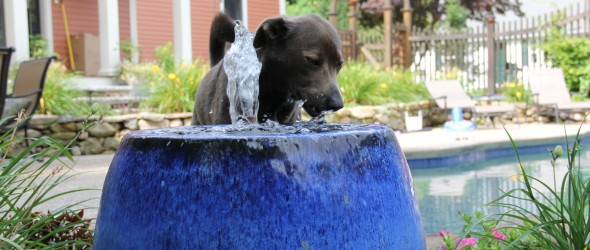
On the contrary, if set up properly a garden water feature should be low maintenance.
The following tips and some good old common sense should provide you with enough information to create and maintain a low maintenance, high enjoyment water feature.
The problem many people have is that they do not maintain their water feature and let the water conditions deteriorate to the point where aggressive measures are necessary.
Here are a few tips I use:
TOOLS: Garden hose Small utility pump Pump hose Cleaning brush Replacement pump pre-filter [if applicable] Water conditioner additive, 5 gallon bucket [for holding stones]
WATER:
Start each season with clean water and remove debris from the basin and around the drip edge. If the water gets too dirty filled with debris then do drain and re-fill as needed.
Algae control is often considered to be the biggest headache in water features, add a cupful of water conditioner like Algefix or bleach once a week. AlgaeFix is a liquid algae-control product for use in ornamental fishponds, water gardens, fountains, and freshwater aquariums.
Check the water level when you add the conditioner and add as needed. The amount of water loss due to evaporation depends on waterfall height, water splashing outside the pond, the amount of sunlight and temperature. If you have to add water to your feature more than normal suspect and inspect for leaks. Common sources of leaks are un-level reservoirs and holes or cracks in the reservoir.
PUMP:
On occasion, you may see a reduction in the water flow over from the basin or fountain head. Usually this occurs when the water level is low and needs to be added. This also might could be a sign that it is time to clean the filter screen on the bottom of the pump. This is a simple process that should take no longer than a few minutes. Simply unplug and remove the pump from the basin for inspection.
On most pumps the screen attachment can be removed for cleaning. Some pumps have a pre-filter and this should be inspected and cleaned as well. Physically remove any debris found on the bottom of the pump. You may also want to physically remove any debris with your hands that may have found its way to the bottom of the basin or reservoir where the pump sits.
DEBRIS:
Remove debris from the basin and splash area as needed. This will keep the water cleaner and the pump free from clogs.
FALL CLOSING:
If your like me and live up north freezing temperatures will crack your basin and damage your pump. To shut your pond down, first unplug your pump, disconnect and remove it from the reservoir.
The pump should be stored in a warm location according to the manufacturers recommendation. Drain the basin and cover it to keep moisture and snow from entering. I suggest draining the reservoir as well. This is a good time to clean the reservoir bottom of debris and sludge. Use a garden hose with a strong stream of water to do this.
SPRING OPENING:
If your reservoir has filled with water it should be drained and all debris and any sludge cleaned out of the bottom. Wash off all the rocks, basin and anything else in the water feature. Pump out the dirty water, clean the bottom again, attach your pump and fill with fresh water. If your water feature involves plants or fish consider following these guidelines.
